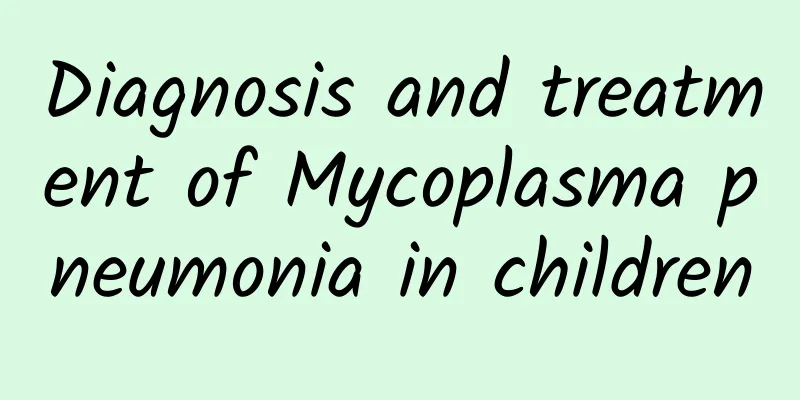Diagnosis and treatment of Mycoplasma pneumonia in children

|
Diagnosis and treatment of Mycoplasma pneumonia in children Mycoplasma pneumonia refers to lung inflammation caused by Mycoplasma pneumoniae infection, which can affect the bronchi, bronchioles, alveoli and lung interstitium. It is the most common community-acquired pneumonia in children aged 5 years and above in my country. Mycoplasma pneumoniae pneumonia is more common in children aged 5 years and above, but children under 5 years old can also develop the disease. The main clinical manifestations are fever and cough, which may be accompanied by headache, runny nose, sore throat, earache, etc. Fever is mainly 38.1-39℃, and continuous high fever above 39℃ indicates a critical condition. The cough is more severe, and a cough similar to whooping cough may occur, and some children experience wheezing. The early signs of the lungs may not be obvious during physical examination, and decreased breath sounds and dry and wet rales may occur as the disease progresses. When the disease progresses to severe Mycoplasma pneumoniae pneumonia, children may experience dyspnea, chest pain, hemoptysis, and other symptoms, as well as extrapulmonary complications such as the blood system, nervous system, and circulatory system. The total number of peripheral blood leukocytes is generally normal or slightly elevated. Mycoplasma pneumoniae culture is the "gold standard" for diagnosing Mycoplasma pneumoniae pneumonia, but Mycoplasma pneumoniae culture requires special conditions and grows slowly, which is not suitable for clinical diagnosis. At present, Mycoplasma pneumoniae-IgM antibodies are generally used as the main method of diagnosis. A single serum antibody titer ≥1:160 is considered to be diagnosed as Mycoplasma pneumoniae pneumonia. The main manifestations of early chest CT of Mycoplasma pneumonia are thickening and increase of peribronchial vascular texture, thickening of bronchial wall, ground-glass shadow, "tree-bud sign", grid shadow, etc. There may also be ground-glass shadow, patchy, segmental and even lobar consolidation. First of all, symptomatic treatment should be given, and attention should be paid to identifying severe and critical cases. Sufficient rest and energy intake should be provided to ensure water and electrolyte balance. Antipyretics should be taken correctly. For those whose dry cough significantly affects rest, antitussive drugs and expectorants can be used as appropriate. Macrolide antibiotics are the first choice for the treatment of Mycoplasma pneumonia, including azithromycin, erythromycin, clarithromycin and roxithromycin. Glucocorticoids can be used appropriately in severe and critical children. Severely ill children with mucus plugging should undergo bronchoscopic intervention as soon as possible. In short, during the peak season of Mycoplasma pneumonia, when children have fever and cough, the possibility of Mycoplasma pneumonia should be considered, and they should go to the hospital in time and receive standardized treatment under the doctor's advice. |
<<: Ultrasound Heart Exam: Understanding Your Unborn Baby's Heart Health
Recommend
How to do pelvic floor muscle repair exercises after childbirth?
Because of the ten months of pregnancy, the press...
How to deal with frequent uterine contractions during mid-pregnancy
From pregnancy to the second trimester, you need ...
Shan Guimin Moxibustion for Uterine Fibroids
Uterine fibroids are a relatively common gynecolo...
Care after hysterectomy
For women in their childbearing years, there are ...
Is foot bathing good for the fallopian tubes?
Nowadays people's living habits are very irre...
What to eat the day before glucose tolerance
You should eat normally the day before the glucos...
Why do we need to do bilateral kidney ECT after completing the renal function test?
Many kidney disease patients have undergone renal...
Demystifying brain injury recovery: Why timing, method and persistence are equally important?
Author: Zhang Hao, Chief Physician, China Rehabil...
What is the cause of blood in urine during early pregnancy?
Pregnant women should pay attention to every deta...
How to remedy lower back pain during confinement?
Women in the confinement period will experience a...
How to apply lipstick on the inside of your lips
Lipstick is a must-have for makeup experts and is...
Is it hard to change the habit of staying up late? It may be the genes that are causing trouble!
As the saying goes, "the early bird catches ...
What should I do if I find an ovarian cyst after pregnancy? Women, watch out.
Many women do not go for physical examinations on...
Pain after breast emptying
If a woman experiences a tingling sensation after...
Female waist pain
There are many reasons for lower back pain. Lower...


![[Fat Bear Science] Freeze me during surgery? What is intraoperative freezing?](/upload/images/67f1ed87db620.webp)






